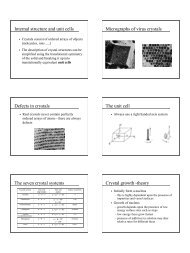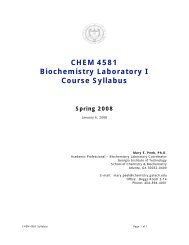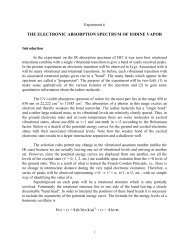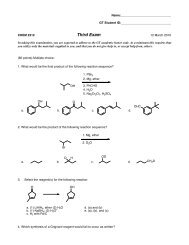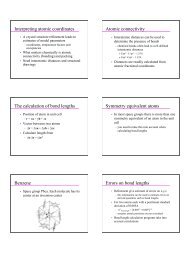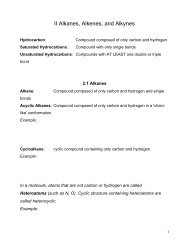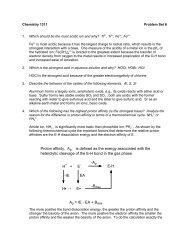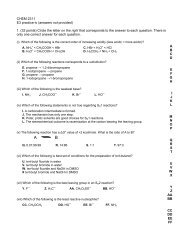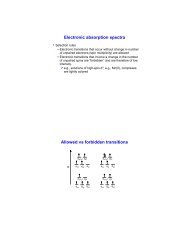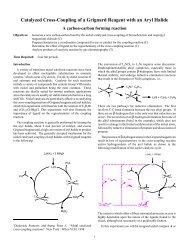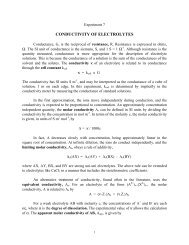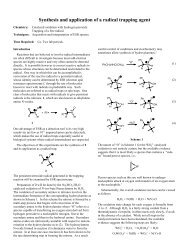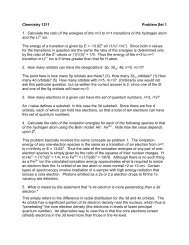Create successful ePaper yourself
Turn your PDF publications into a flip-book with our unique Google optimized e-Paper software.
Name_______________________________________<br />
Chem 1311 <strong>Final</strong> <strong>Exam</strong> 15 December <strong>2000</strong><br />
In taking this examination, you are expected to adhere to the GT academic honor code.<br />
At a minimum this requires that you utilize only the materials supplied to you (except for<br />
a non-programable calculator), and that you do not give help to, or accept help from,<br />
others. Calculators cannot be shared. Numerical problems must show all equations<br />
used to arrive at an answer; zero credit will be given for just the answer.<br />
1. Shown to the right is the pH vs volume curve for<br />
titration of 15 mL of a weak base with 0.10 M HCl.<br />
a) (6) Calculate the concentration of the weak base in<br />
the original solution.<br />
0.010 L x 0.10 mol/L = 0.0010 mol H + = 0.0010 mol B<br />
0.0010 mol B/0.015 L = 0.067 M B in original solution<br />
b) (3) If the endpoint was to be determined using an<br />
indicator, what would be the ideal value of the pK a of<br />
the indicator?<br />
5<br />
c) (3) What is the pK b of the weak base?<br />
pK b =pK w - pK a = 14 - 9 = 5 (see next part)<br />
pH<br />
12<br />
11<br />
10<br />
9<br />
8<br />
7<br />
6<br />
5<br />
4<br />
3<br />
2<br />
1<br />
0<br />
0 2 4 6 8 101214161820<br />
volum e 0.10 M acid added<br />
d) (3) What is the pK a of the conjugate acid of the weak base?<br />
pH = pK a + log [B]/[BH + ] at half-equivalence point pH = 9. Therefore pK a = 9<br />
2. (12) Equimolar amounts of F (as the sodium salt), (CH 3 ) 2 S, Hg 2+ (as the nitrate salt) and BF 3<br />
are combined in a suitable solvent. What are the four possible acid-base products? Circle the<br />
two acid-base reaction products predicted to be present in greatest amount after equilibrium is<br />
established. Assume a 1:1 stoichiometry for all acid-base reactions.<br />
BF 4<br />
<br />
HgF + (CH 3 ) 2 SBF 3 (CH 3 ) 2 SHg 2+<br />
3. (6) Which of the compounds FeO, Fe 2 O 3 , FeS, or Fe 2 S 3 is most likely to have the largest<br />
lattice energy? Briefly explain the basis for your choice.<br />
Lattice energy is proportional to the product of the charge on the ions and inversely proportional<br />
to the internuclear separation between cation and anion. Thus Fe 2 O 3 will have the largest<br />
lattice energy since it has the smallest and most highly charged ions
4. (14) Draw all diastereoisomers of the complex [Co(H 2 NCH 2 CH 2 S)(H 2 NCH 2 CH 2 NH 2 )(Cl) 2 ].<br />
Indicate those isomers that are optically active (have nonsuperimposible mirror image forms) by<br />
drawing a box around the structure. You may abbreviate the chelating ligands as N ð N and<br />
S ð N in making your drawings.<br />
Cl<br />
+ N<br />
+ N<br />
+<br />
N<br />
S<br />
Co<br />
N<br />
N<br />
N<br />
S<br />
Co<br />
Cl<br />
Cl<br />
N<br />
N<br />
Co<br />
Cl<br />
Cl<br />
Cl<br />
N<br />
S<br />
5. (15) a) Draw structures of the following molecules and ions. Your structures should: i) depict<br />
the geometry of the species, ii) show the location of all non-bonding electron pairs, if any, on all<br />
terminal atoms and, iv) show formal charges on individual atoms consistent with the number of<br />
valence shell electrons assigned to each and consistent with the overall charge on the species.<br />
b) For each of the above species indicate what hybrid orbital set would be utilized for bonding<br />
by the central atom.<br />
Hybrid orbital set<br />
SOCl 2<br />
..<br />
sp 3<br />
..<br />
Cl S ..<br />
.. O<br />
..<br />
Cl<br />
..<br />
ICl 4<br />
<br />
NO 3<br />
<br />
..<br />
- O<br />
+<br />
N<br />
- O<br />
..<br />
..<br />
O..<br />
..<br />
Cl ..<br />
..<br />
Cl<br />
..<br />
..<br />
-<br />
I<br />
..<br />
..<br />
Cl<br />
..<br />
Cl<br />
..<br />
sp 3 d 2<br />
7. (6) Give ground state electron configurations for the following species and indicate the<br />
number of unpaired electrons for each.<br />
Co 3+ [Ar]3d6 Sn + [Kr]5s 2 4d 10 5p 1<br />
sp 2<br />
unpaired electrons __4____<br />
unpaired electrons __1____<br />
page 2 of 7
8. Shown below the molecular orbitals for CO 2 (O=C=O).<br />
a) (6) Indicate which orbital (by number) is the HOMO (highest occupied molecular orbital) and<br />
which is the LUMO (lowest unoccupied molecular orbital) and whether each is σ bonding (σ b ), σ<br />
nonbonding (σ n ), σ antibonding (σ*), π bonding (π b ), π nonbonding (π n ), or π antibonding (π*).<br />
HOMO 5 π n LUMO 4 π*<br />
b) (8) Attack of hydride ion (H - ) at the LUMO of CO 2 will result in the formation of the formate<br />
anion. Draw resonance structures of the formate ion that indicate that the carbon-oxygen<br />
bonds are equivalent. Your Lewis structures must show all valence shell electron pairs and<br />
formal charges on the appropriate atoms.<br />
-<br />
..<br />
O<br />
What is the bond order of the C-O bonds?__1.5__________<br />
c) (5) Draw the bonding molecular orbital that would describe π bonding in the anion that is<br />
equivalent to the resonance structures in part b). (Be careful to take into account the relative<br />
contribution and phase of each atomic orbital involved in the molecular orbital.)<br />
H<br />
C<br />
..<br />
O..<br />
..<br />
O<br />
H<br />
C<br />
..<br />
O..<br />
-<br />
H<br />
C<br />
O<br />
O<br />
page 3 of 7
9. (7) Iridium metal has a face-centered unit cell with a cell dimension<br />
of 3.833 Å. Calculate the density of the metal in g cm -3 .<br />
−1<br />
4 atoms x 192.217 g mol<br />
23 −1<br />
d =<br />
6.022 x10 atoms mol<br />
−8 3<br />
=<br />
(3.833 x10 cm)<br />
22.67 g cm<br />
3<br />
10. (6) Briefly explain why many coordination compounds absorb in the visible region of the<br />
electromagnetic spectrum and are therefore colored.<br />
Interaction between a metal ion and ligands results in a splitting of the d orbitals into two or<br />
more groups, depending upon the number and geometry of the ligands, of different energy.<br />
Often the energy difference in the groups of d orbitals is comparable to that of visible light and<br />
excitation of electrons from the lower energy orbitals to the higher energy orbitals can occur<br />
with absorption of photons which gives the appearance of color.<br />
11. (12) Assume that the ions H 3 + and HFH + are both linear. Describe the bonding in each ion<br />
in terms of the molecular orbitals formed and the number of electrons available to populate the<br />
bonding orbitals. Be careful to explicitly describe differences in the nature of the bonding in the<br />
two species. Simple orbital energy level diagrams could be useful in this regard, although not<br />
absolutely necessary. In HFH + assume that the fluorine atom uses its s and one of the p atomic<br />
orbitals to bond to the hydrogen atoms.<br />
antibonding, no electrons<br />
nonbonding, no electrons<br />
bonding, 2 electrons<br />
H + 3 is electron deficient<br />
antibonding, no electrons<br />
antibonding, no electrons<br />
bonding, 2 electrons<br />
bonding, 2 electrons<br />
HFH + is not electron deficient<br />
H<br />
F p<br />
F s<br />
page 4 of 7
12. (42) Circle the answer corresponding to the correct answer for each of the following.<br />
Which species requires the most energy for ionization?<br />
a) Cl 1- b) Ar « K 1+ d) all are the same<br />
Which species has the largest radius?<br />
« Cl 1- b) Ar c) K 1+ d) all are the same<br />
Which of the following substances is most likely to be a solid at room temperature?<br />
a) SO 2 b) ClO 2 « GeO 2 d) NO 2<br />
Which of the following species has the lowest bond order?<br />
1-<br />
1+<br />
a) O 2 b) O 2 c) O 2<br />
« O 2<br />
2-<br />
Which of the following species has the smallest number of unpaired electrons?<br />
1-<br />
1+<br />
2-<br />
a) O 2 b) O 2 c) O 2 « O 2<br />
Which should have the largest ionization energy?<br />
1-<br />
1+<br />
a) O 2 b) O 2 « O 2<br />
d) O 2<br />
2-<br />
Which of the following molecules will have an ionization energy that is less than that of the atom<br />
of the element of which it is composed?<br />
a) N 2 b) C 2 c) B 2 « none of these<br />
Which coordination complex should have the largest number of unpaired electrons (fluorine is a<br />
weak field ligand)?<br />
a) [CrF 6 ] 3- b) [MnF 6 ] 3- « [FeF 6 ] 3- d) [CoF 6 ] 3-<br />
Which should be the most acidic species<br />
« [Al(OH 2 ) 6 ] 3+ b) [Ru(OH 2 ) 6 ] 3+ c) [Mg(OH 2 ) 6 ] 2+ d) none of these is acidic<br />
Which of the following has the highest proton affinity (is the strongest base)?<br />
« NH 2 <br />
+<br />
b) NH 2 c) NH 3 d) NH 4<br />
Band structure diagrams are shown below for three substances. Which is most likely to be an<br />
insulator? The shaded area represents the fraction of the band that is filled.<br />
a) « c) d) none of these<br />
p<br />
p<br />
p<br />
s<br />
s<br />
Which of the following compounds will generate the largest number of ions in solution?<br />
« K 4 [Fe(CN) 6 ] b) [Co(NH 3 ) 6 ]Cl 3 c) Na 2 [PtCl 6 ] d) [Ni(NH 3 ) 6 ](PF 6 ) 2<br />
s<br />
Which of the following phosphorus-chlorine species is most likely to not be a stable moiety?<br />
+<br />
<br />
a) PCl 4 b) PCl 5 « PCl 2 d) PCl 6<br />
page 5 of 7
13. (36) Answer six (ONLY) of the following. Letter each answer to match the question and<br />
continue on the next page as necessary. Use balanced reactions and diagrams to illustrate<br />
your answer whenever possible. Keep your rhetoric to a minimum (40 words or less per<br />
answer).<br />
a) [Fe(OH 2 ) 6 ] 2+ has four unpaired electrons, whereas [Fe(CN) 6 ] 4 is diamagnetic.<br />
b) Doping silicon with a small amount of gallium greatly increases its conductivity.<br />
c) Addition of SO 2 to aqueous base decreases the basicity of the solution.<br />
d) The equilibrium constant for the reaction [Ni(en) 2 (OH 2 ) 2 ] 2+ + trien = [Ni(trien)(OH 2 ) 2 ] 2+ + 2 en<br />
is >>1. en is H 2 NCH 2 CH 2 NH 2 ; trien is H 2 NCH 2 CH 2 NHCH 2 CH 2 NHCH 2 CH 2 NH 2<br />
e) The pK a for unbound water is 14; however, when coordinated to certain metal ions its pK a<br />
may drop to values as low as 2-3.<br />
f) Compared to CO and O 2 , CS and S 2 are very unstable molecules and can be generated only<br />
at very low concentrations in the gas phase.<br />
g) A gas is evolved when CH 3 CH 2 CO 2 D is added to a suspension of NaH in in THF (an inert<br />
solvent).<br />
h) A gas is evolved when Ca 3 P 2 is treated with water.<br />
i) Phosphine reacts with NaNH 2 in liquid ammonia or in organic solvents such as THF (a cyclic<br />
ether) where NaPH 2 is produced by the reaction NaNH 2 + PH 3 S NaPH 2 + NH 3 . However,<br />
phosphine does not react with NaNH 2 in water.<br />
page 6 of 7
a) Both complexes contain d 6 Fe(II). Water is a weak field ligand whereas CN is a strong field<br />
ligand. Thus the former complex is high spin and the latter is low spin.<br />
b) Addition of gallium to silicon results in the creation of holes in the valence band which act as<br />
low-lying acceptor levels for electrons and the formation of a p-type semiconductor.<br />
c) SO 2 + OH = HOSO 2 or SO 2 + 2 OH = SO 3 2 + H 2 O<br />
d) This is an example of the chelate effect, which is primarily entropy driven. Formation of the<br />
products results in the formation of an additional free molecule.<br />
e) Coordination of water to a metal ion results in electron transfer from the oxygen to the metal<br />
and effectively an increased electronegativity for the oxygen atom. This in turn increases the<br />
polarization of the O-H bond and its acidity.<br />
f) CS and S 2 are multiply bonded species and contain third row elements. Pi bonds involving p<br />
orbitals of heavier elements are weak relative to sigma bonds involving sp hybrid orbitals. Thus<br />
such molecules are unstable to reaction with themselves or other molecules to form sigma<br />
bonded frameworks.<br />
g) CH 3 CH 2 CO 2 D + LiH = HD + Li + + CH 3 CH 2 CO 2<br />
<br />
h) Ca 3 P 2 + 6 H 2 O = 3 Ca 2+ + 6 OH + 2 PH 3<br />
i) NH 2 will react with water according to NH 2 + H 2 O = NH 3 + OH . Hydroxide is not a strong<br />
enough base to deprotonate PH 3 . The intrinsic basicity of NH 2 has been leveled to that of OH .<br />
page 7 of 7




